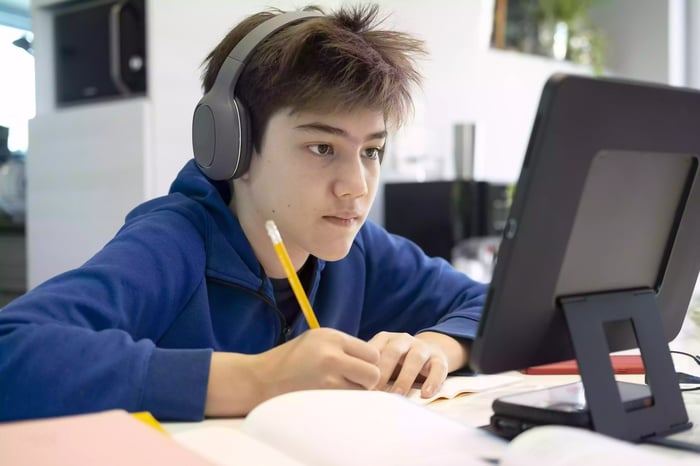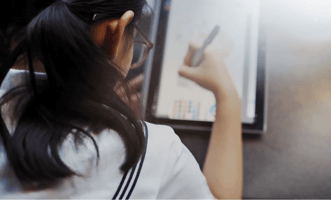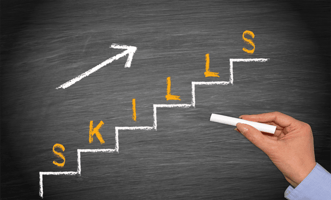This series, entitled ‘Fostering 21st Century skills in the digital classroom’ helps teachers...
Edtech supporting the safe use of technology in learning
Learning technology has become a reality, and it’s an idea that instils a sense of panic in many of us—especially as educators and parents. We see the results of too much screen time in younger learners in particular. So how is it that we can strongly advocate for digital education as the best way forward? It seems like a paradox, but it may be that this new generation of learning technology will revolutionise learning like never before through edtech, supporting safe use of technology in learning. We simply need to re-imagine everything we’ve thought about learning so far.

Screens surround us all in daily life, so now is the best time to understand how to use learning technology responsibly and maximise screen time usage. Maintaining a strong human element through thoughtful learning design with learning technology may be key to achieving this balance with active student engagement and positive self-regulation habits.
Personalised learning to accelerate productivity in edtech
We need to learn how to optimise learning and to live with tech as a whole. This seems like a massive undertaking, so where to even begin? The answer could lie in personalised learning, which can accelerate student learning productivity through thoughtful management and learning technology guidelines created by designers, teachers and parents.
Personalised learning is a standard in many curriculums globally, and learning technology can assist by allowing for student autonomy and consequently, a higher level of engagement. This is a huge challenge for teachers, especially with large class sizes.
A new generation of school models blend learning activities into productive steps of personalised learning experiences. For example, New Tech Network implemented learning models using personalised learning based on accurate student diagnoses and individually paced content mastery. The organisation additionally combined this aspect with project-based learning.
This combination creates long-term challenges that promote deeper-learning competencies like critical thinking, working collaboratively, problem-solving, and taking responsibility for one’s own learning. The schools involved have experienced increased graduation rates and college enrollment.
When creating personalised learning, designers can consider certain aspects of learning outcomes and the learner profile to optimise content screen time. What should young people know and be able to do? What kinds of experiences will help them develop important knowledge, skills, and personal qualities? It’s possible to support learners to develop a balance of online and offline learning experiences.
Some aspects to consider with personalised learning:
- Engage students by giving them a voice and choice in how, when, and what they learn. Learning technology can facilitate this.
- Blend learning activities into productive steps of personalised learning experiences.
- Adults can help young people develop positive self-regulation habits, and understand why we behave in certain ways with learning technology.
How we can re-imagine learning
Learning technology has created powerful and diverse platforms to help re-imagine learning, which can result in designers maximising both screen time and active student engagement.
Learning for the digital medium has endless possibilities. It allows for student-centered learning that is personalised and competency-based. This means learning can happen anytime, anywhere, and motivate students to take ownership of their learning. It’s not confined to the regular school hours and doesn’t have to take place in a regular classroom. Learning technology can help motivate and accelerate learning, and learning technology such as AI, AR, and VR will likely play a role.
For more on the role of student-centred learning in education, read our article, Teacher-centred learning: one size fits no one?
A 2015 study of 22,000 high-school students asked how they felt in school, and the top answers were tired, stressed, bored. Learning stalls out when students are not actively engaged. Students need opportunities to take on big issues, collaborate with diverse teams, and innovate in ways that allow them to contribute to their communities.
Instead of focusing on grades and scores, young learners should be supported in ways that encourage them to create and invent, launch social movements, and even contribute to solving global problems. Teachers and designers can encourage innovation with available learning technology and platforms.
How can we change these feelings and attitudes around learning? Good teaching matters, but even more important, is giving students autonomy over their own learning. Ideas around education need to shift to value learning over seat time, growth over proficiency, and production over consumption.
Reclaiming mental space
Part of maintaining a human element in learning design includes having guidelines set by teachers, designers and parents, which are just as crucial in supporting the safe use of learning technology. We need to teach positive self-regulation habits to young learners.
By doing this we can reclaim ‘mental space.’ We need to become more intentional with learning technology use and reduce the amount we use it. Studies support users feeling more creative and able to generate new ideas, less stressed and better able to achieve their goals when this happens. In short, boredom can be good! For students, more tech downtime can mean higher levels of active engagement.
We know the increased use of technology has changed us. One example is that our attention shifts more quickly. Studies quantify the risks of social media and cellphone usage, with one finding students were only able to stay focused for 6 minutes because of these distractions.
Additionally, the multitasking and constantly switching tasks that is a result of being surrounded by technology significantly deletes brain glucose. Ongoing multitasking pushes the brain to the point where we can’t make decisions anymore and completely lose productivity.
Science supports activating the ‘default mode’ of the brain to open it up for creativity and problem-solving by turning off technology. Reclaiming this mental space matters, and unplugging and allowing for daydreaming is a crucial step. It’s reclaiming a child-like sense of curiosity to stop and wonder about and connect with the world around us.
Here are some ways to decrease screen time and reclaim mental space:
- Limit your multitasking
- Tidy up phone apps, delete a heavily used app for one day each week
- Be selective in what information you consume
- Discuss topics with others each day for 7 minutes, in person or by phone
- Set information goals for each week: creativity, news, connecting with family/friends, or learning a language
Managing information has become such a challenge, that Informagical was founded for this very reason. They help people manage information overload.
Starting today
The responsibility lies with teachers and designers to optimise student learning within this digital world. We need to maximise screen time with edtech, give students autonomy, while also encouraging them to take time away from learning technology.
This vision calls for intentional learning design for learning technology by designers and teachers that focuses on personalised learning while decreasing the stresses associated with high screen use. We need to be thoughtful about the future of education to encourage active engagement and creativity in learners instead. Learning technology gives us a way to hand learning back to the students, so let’s welcome this new face of education!
References
- Make information overload disappear. (n.d.). Retrieved from https://project.wnyc.org/infomagical/
- Lee, L. (2019, September). Why boredom often beats screen time. Retrieved from https://www.edutopia.org/article/why-boredom-often-beats-screen-time
- Noonoo, S. (2019, June). Why Science says boredom is good for the brain. Retrieved from: https://www.edsurge.com/news/2019-06-25-why-science-says-boredom-is-good-for-the-brain
- Vander Ark, T. (2018). The problem is wasted time, not screen time. Retrieved from https://www.educationnext.org/problem-is-wasted-time-not-screen-time-forum-scoggin-vander-ark/



